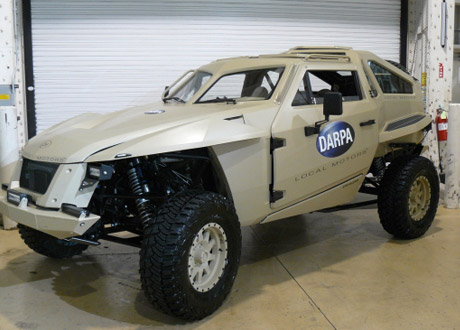By: Gaurav Bhalla
With each new success story generated from collaboration and co-creation, a diverse range of organizations are following suit. Gaurav Bhalla shares a co-creation accomplishment recently recognized by President Obama, involving Local Motors and a government defence agency.
For close to a year now, beginning with my book “Collaboration and Co-Creation: New Platforms for Marketing and Innovation,” and more recently in my blog posts and conference presentations, I have maintained that the government and the nonprofit sector is a very fertile ground for co-creation. This assertion was amply supported at the recently concluded PDMA conference on Co-Creation, held in Phoenix on July 27-28. What made the conference even more interesting was that the first day of the conference was hosted by Local Motors, the only company in USA that co-creates cars with its customers (I will be writing more about Local Motors in my upcoming blogs).
The topic of this blog has less to do with the agenda of the conference and more to do with what happened a few days before involving the host Local Motors and a leading American Defense Agency, leading to recognition and applause by none other than President Obama himself. This blog’s theme is the celebration of the power of co-creation in a sector that one would least expect to be among the early adopters – a government defense agency.
Earlier in the year, DARPA (Defense Advanced Research Projects Agency) asked Local Motors to design, develop, and deliver a next generation combat support vehicle. Local Motors turned to its community of designers and experts and delivered the XC2V (Experimental Crowd-derived Combat-support Vehicle) in record time. The entire project – from concept to delivery – took 6 months, thereby demonstrating unequivocally how the process of co-creation can effectively increase the rate of innovation and efficiency, even in the most exacting of environments and applications.

It was this achievement, the fact that the X2CV was produced using a new approach to manufacturing, a co-creation approach, as opposed to a proprietary approach, that impressed President Obama and the White House the most. As the White House blog noted – rather than the usual contracting model that takes several years, DARPA working with a small company in Arizona, Local Motors, was able to fulfill the challenge in a little over four months.
So, how was Local Motors able to do in a few weeks what traditional contracting models took years to achieve? By relying on the co-creation potential of its community of designers and experts and its own micro manufacturing facilities. With only four weeks for planning, Local Motors democratized the process by receiving 162 high quality designs from hundreds of entrepreneurs and spent fourteen weeks building the car.
This is not just a one-off deal. In his subsequent address at Pittsburgh’s Carnegie Mellon University, the President used the success of the X2CV to kick-off the Advanced Manufacturing Partnership (AMP), a national collaboration between the government, industries, and universities to invest in cutting-edge technologies. The AMP is geared towards helping U.S. manufacturers reduce costs and speed ideas from the drawing board to the manufacturing floor, creating high quality jobs and increasing U.S. global competitiveness in manufacturing. There is every indication that co-creation will play a major role in producing these gains in productivity and efficiency. A clip of relevant portions of the President’s speech can be seen here.
In addition to celebrating the success of the X2CV, and recognizing the success of innovative businesses like Local Motors, the President was also introduced to the vehicle itself, the community co-created DARPA XC2V, the Local Motors CEO, Jay Rogers, and the winning designer of the XC2V “Flypmode”, Victor Garcia.
My gut tells me this is not the last time I will be celebrating the adoption and application of co-creation by a government agency and/or nonprofit. The potential to make a difference is truly immense.
About the author:
 Gaurav Bhalla is a strategy, innovation, and marketing professional with global experience, having worked on three continents and with companies in over 20 countries. He is also owner and CEO of Knowledge Kinetics. The company focuses on the practice of customer-driven innovation and value co-creation.Gaurav previously was the Global Innovation Director, at Kantar-TNS, one of the world’s largest market information and insight companies. Additionally, he held positions in corporate strategy, brand management, sales management, and market research at companies such as Nestle, Richardson Vicks, and Burke.
Gaurav Bhalla is a strategy, innovation, and marketing professional with global experience, having worked on three continents and with companies in over 20 countries. He is also owner and CEO of Knowledge Kinetics. The company focuses on the practice of customer-driven innovation and value co-creation.Gaurav previously was the Global Innovation Director, at Kantar-TNS, one of the world’s largest market information and insight companies. Additionally, he held positions in corporate strategy, brand management, sales management, and market research at companies such as Nestle, Richardson Vicks, and Burke.
Dr. Bhalla holds a BA (Hons.) degree in Economics and Mathematics from Delhi University, an MBA with a concentration in Marketing and Finance from the Indian Institute of Management, Ahmedabad, and a PhD in Business from the University of Kansas. He has published research papers in leading technical journals dedicated to marketing, marketing research and statistics, and has presented before professional and academic societies in the USA and abroad. Dr. Bhalla has also served as an adjunct professor at Duke University’s Fuqua School of Business. He is currently associated with the University of Maryland’s Smith School of Business as a member of the Department of Marketing’s Corporate Advisory Board.
